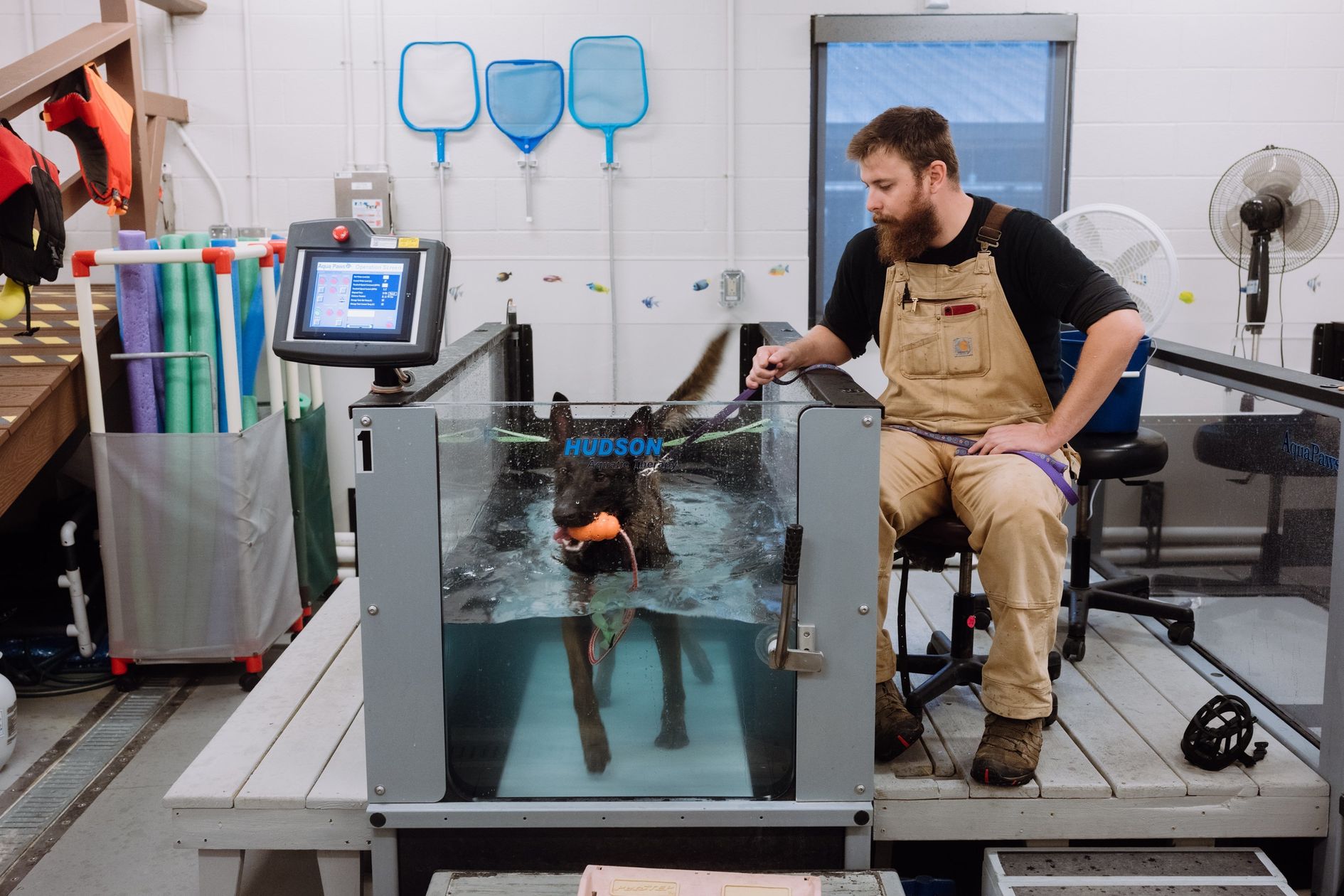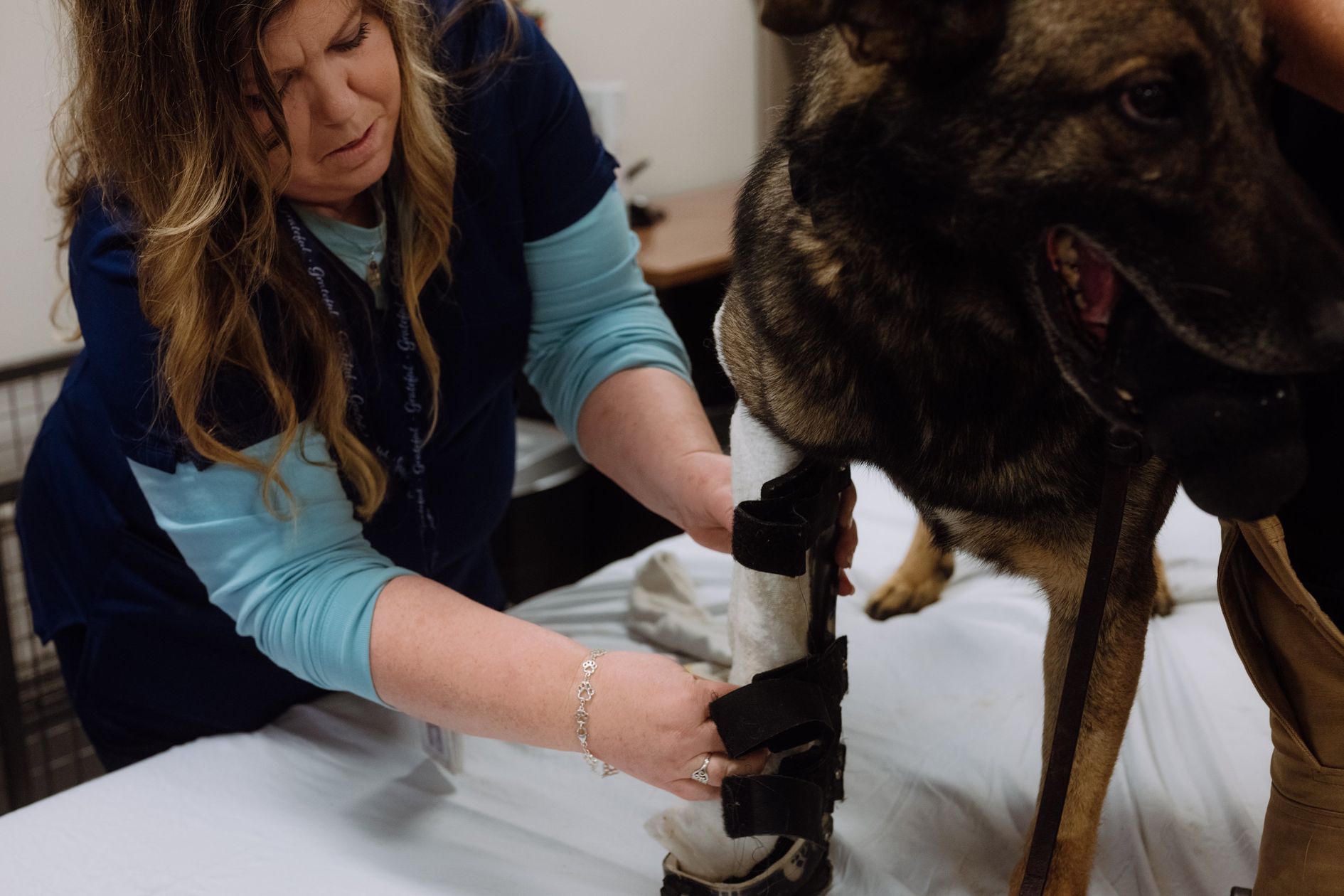Military dogs at Premier Rehab Center do push-ups and yoga
‘Canine tactical athletes’ are flown in from around the world for care. Some patients are so eager to get started they body slam the clinic’s doors.

Hundreds of dogs are treated each year at the military working dog hospital in San Antonio, Texas. WSJ
By James R. Hagerty / Photographs by Christopher Lee for The Wall Street Journal December 30, 2022
San Antonio, Texas — At the U.S. military’s working dog hospital here, being treated like a dog isn’t so bad.
Dogs fly in from all over the world for treatment at the hospital’s rehabilitation center. Some are so eager to start daily exercises that they body slam the clinic’s doors. Rewards for good behavior include squeeze toys and frozen chicken chunks.

Downward dog
The dogs—mostly German shepherds, Belgian Malinois or related breeds—get premium treatment because they have important jobs, such as patrolling military bases, finding hidden explosives or searching for illegal drugs. They are known as “canine tactical athletes” or “four-legged war fighters.”
The U.S. military has more than 1,000 working dogs worldwide, and hundreds are treated each year in San Antonio.
While they’re getting rehab, dogs also can see a dentist. The hospital performs about 100 root canal operations a year, said Col. Nic R. Cabano, head of the veterinary service. Dental care is vital, he said, partly because “one of our key priorities is to preserve the biting strength.”
During rehab exercises, “you can’t tell them to do crunches,” said Andrea L. Henderson, head of rehabilitation services at the base, “but you can teach them to do push-ups or squats.” Dog push-ups involve standing with the front feet up on a plastic table, crouching down on forearms and standing up again. Squats require sitting down on command, with the front feet elevated on a higher surface.
“That’s a good core and hind-leg workout,” Dr. Henderson said.

Working dogs learn rehabilitation exercises during their stay. WSJ
She likens the dogs to human athletes. Given proper care, Dr. Henderson said, “we would hope for a seven- or eight-year career.” Without such care, working dogs can wear out and be forced into early retirement.
On a recent morning, one of her patients was a Belgian Malinois called Qqasi. The dog, nearly 2 years old and highly excitable, landed wrong during a training exercise and tore an ankle ligament. Surgeons had repaired the ankle with plates and screws. Qqasi, who had been hobbling on three legs, was starting to use the wounded limb tentatively.
After a stroll on a grassy patch outside, he was sent for a session on the underwater treadmill, inside a clear plastic tank with water rising up to the dog’s shoulder. The water provides buoyancy, taking some of the weight off Qqasi’s wounded leg. Water also is like a resistance band, forcing more exertion than required for regular trotting.
Qqasi was still getting used to the tub but propelled himself doggedly and occasionally splashed his minders.

Chris Hoyenski, a caretaker and former Army medic, with a patient. WSJ

A session on an underwater treadmill. The water provides buoyancy, taking some weight off a dog’s wounded leg. WSJ
His next stop was a padded table in a room with dim lighting meant to calm animals. Dr. Henderson wanted to begin teaching him other exercises, but he was thrashing around so much that she and a muscular attendant struggled to hold him in place.
“You’re all right, you’re all right, buddy,” Dr. Henderson said softly. She tossed Qqasi some frozen chicken.
Still, he was too wound up. Dr. Henderson sent him off for R&R.
“These dogs were made to be hyper-focused on something,” such as following a scent or repelling an infiltrator, she said. That’s great for job performance but sometimes makes it hard to calm down and learn a new trick. “We want them to have extremely high drive,” she said, but some are “off their rocker.” Animal behaviorists are on hand to determine what might be triggering a dog’s meltdown.
Rehab is increasingly popular for civilian dogs, horses and other animals too. Some animals injure themselves in competitions, such as dock diving for dogs. Others are ordinary pets succumbing to the ravages of age.
“It has become quite mainstream,” said Dr. Darryl Millis, director of a canine arthritis and rehab center at the University of Tennessee, Knoxville. He finds people want pets to receive services similar to what humans get in physical therapy.

Dogs come from all over the world for treatment at the hospital’s rehabilitation center. WSJ
The dogs tend to compare favorably with humans. “As a generality, dogs do not have this thing in their brain that tells them they have a fracture and can’t move, so a dog never has an excuse,” said Sasha A. Foster, rehab coordinator at Colorado State University’s veterinary teaching hospital.
Chance, a 13-year-old yellow Labrador, regularly visits Elizabeth Wade, a veterinarian in Monroeville, Pa., for exercises designed to strengthen her hind legs, troubled by ligament tears. “She loves Dr. Wade,” said Chance’s owner, Lori Kleppick.
At the San Antonio military base, in a room decorated with a Christmas tree bearing glittery pictures of dogs, a German shepherd named Nox was recovering from a severe sprain. One of Dr. Henderson’s assistants dangled a chew toy to lead Nox on a walk threading through a row of plastic cones and over low plastic tubes. Nox waited for a command before grabbing his reward, the toy.
“Somebody taught this dog really good impulse control,” Dr. Henderson said.

Given proper care, working dogs can have longer careers. WSJ

Dr. Andrea Henderson, head of rehabilitation services at the base, with a patient. WSJ
She coaxed another dog, Aarianna , to walk backward, working hamstrings and glutes. “Back! Back! Back!” Dr. Henderson said. “Good girl!”
Other canine-rehab exercises include walking in figure eights, touching the nose to the hips or crouching to reach for a treat under a low table. For dogs, lifting one paw to shake hands, while keeping balance in a standing position, is roughly equivalent to a superman pose in yoga, Dr. Henderson said.
Picking the right type of reward can be tricky. “We have to find a reward that is enticing but not too enticing,” she said. Meat or low-sodium cheese spread are high-value rewards that work for some dogs but can overstimulate others. Dry dog food can be a calming alternative. “Most dogs will work for kibble,” she said, “but they aren’t going to work that hard for it.”
At the San Antonio base, dogs too old or worn out for further military work still get rehab care to prepare them for adoption. All dogs are given an honorary rank one notch above that of their human handlers. The idea, said Col. Cabano, is “to reinforce honor and respect for the canine partner.”

Chew toys and frozen chicken chunks are given to patients as rewards. WSJ
| Write to James R. Hagerty at bob.hagerty@wsj.com |
 Source The Wall Street Journal
Source The Wall Street Journal
Also see
Rehabilition Goes to the Dogs The University of Tennessee
